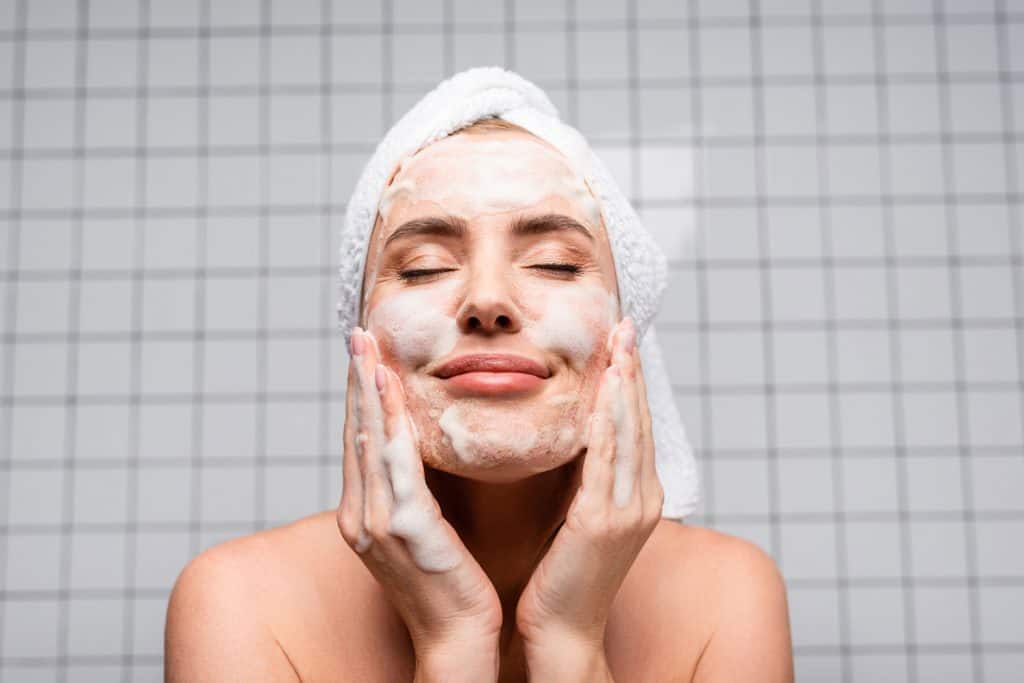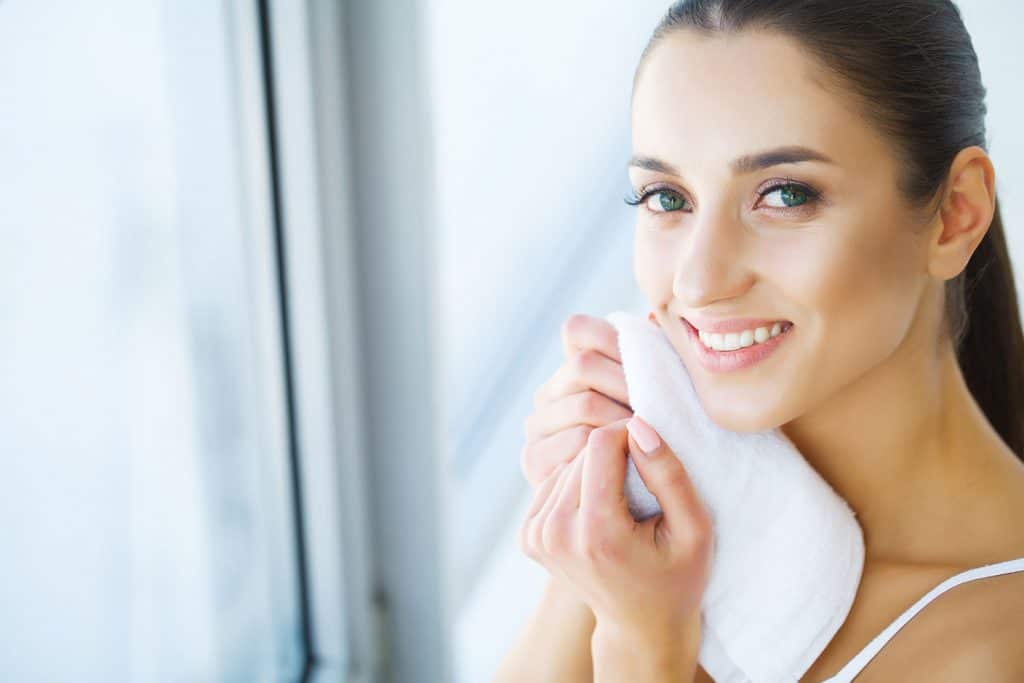Gone are the days of your mom rubbing your face with a wet washcloth and calling it clean. Adulting requires a bit more effort in your skincare regimen. The first step, of course, is cleansing your face.
There are a lot of different types of face cleansers available on the market. From gel to foam, facial cleansers offer not only a variety of textures but also a clean slate for the rest of your skincare routine. It is important to understand which kind of cleanser is best for your skin type so as not to cause damage to your skin. Here are the 11 types of face cleansers we will discuss in this article:
- Gel
- Foam
- Cream
- Micellar Water
- Oil
- Milk
- Clay
- Powder
- Bar
- Exfoliating
- Organic
It is important to know that every cleanser has distinct advantages and disadvantages. If you invest the money into these products, you'll want tips on how to use them effectively. We will cover all of these topics in this article, as well as the benefits of double-cleansing.

This article may include affiliate links and elements that were carefully created by our team using advanced ai to help you envision the best style advice.
1. Gel Cleanser
This water-based cleanser has a jelly-like texture and is good at removing make-up as well as cleaning dirt from pores. Gel cleansers eliminate surface oils and acne-causing bacteria. If you're looking for a deep clean, this is a good face wash for that. On the flipside, gel cleanser can be harsh on sensitive skin, doesn't lather up like other soaps, and can leave your skin feeling tight. Gel cleansers are best for oily, acne-prone, and normal skin.
Our Favorite Gel Cleanser: Epionce Lytic Gel
Click here to see this product on Amazon.
2. Foam Cleanser
This soap-based cleanser forms into an impressive lather to effectively remove all cosmetics, impurities and give you a squeaky-clean feeling. Most foam cleansers contain an ingredient called sodium lauryl sulfate, also known as SLS. This is what creates all those beautiful bubbles, but it also causes your skin to dry out. Most foam cleansers are too harsh for sensitive skin, so we recommend you use this type of cleanser if you have oily skin.
Our Favorite Foam Cleanser: EltaMD Foaming Facial Cleanser
Click here to see this product on Amazon.
3. Cream Cleanser
A cream cleanser has a thick lotion-type consistency and comes in both water-soluble and not water-soluble formulas. This cleanser is deeply moisturizing, non-abrasive, and very gentle. Unfortunately, it does not provide a deep clean for oily skin. Sometimes it leaves behind a residue that could clog pores. Cream cleansers are desirable for those with dry or sensitive skin.
Our Favorite Cream Cleanser: Neutrogena Ultra Gentle Hydrating Cleanser
Click here to see this product on Amazon.
4. Micellar Water
This cleanser has exploded in popularity, but what is it, and how does it clean your skin? Essentially a micellar cleanser contains microscopic oil molecules suspended in water, and because of the design of these molecules, they attract oil and makeup like a magnet. The advantages of using micellar water are that it is gentle, hydrating, and there is no need to rinse it off your face, which makes it ideal for camping, road trips, or whenever you don't have access to water. However, it doesn't provide a deep clean, and if you're wearing a full face of makeup, you may have to use a lot of product. All skin types can use micellar water.
Our Favorite Micellar Cleanser: Bioderma Micellar Water
Click here to see this product on Amazon.
5. Oil Cleanser
Yeah, we said oil cleanser. This advanced skincare product is a blend of oils designed to attract debris and oil off of the skin. Oil cleansers tend to be surfactant-free, which means it is very gentle and provides good hydration. A word of warning, though, these cleansers can come with a lot of trial and error. You need to know your skin type and what oils are best for you because reading product labels can be quite time-consuming.
Also, due to the nature of the product, the application can get messy. Surprisingly oil cleanser is good for all skin types, but do your due diligence and make sure the product is appropriate for your skin.
Our Favorite Oil Cleanser: Hanskin Pore Cleansing Oil
Click here to see this product on Amazon.
6. Milk Cleanser
Just because it says milk in the name doesn't mean this cleanser actually contains milk. The name actually comes from the milky appearance this cleanser possesses. Its texture is thinner than cream but thicker than an oil cleanser. A milk cleanser is great at removing makeup while moisturizing your skin at the same time. Another positive is that these cleansers typically don't leave behind a residue like cream cleansers.
Be that as it may, milk cleansers don't provide a very deep clean and so are best utilized as a pre-cleanser. Those with dry to normal skin will get the most benefit from this type of cleanser.
Our Favorite Milk Cleanser: TULA Skincare Super Calm Gentle Milk Cleanser
Click here to see this product on Amazon.
7. Clay Cleanser
Formulated with special detoxifying clay, this cleanser behaves similarly to clay masks. Don't expect this cleanser to remove your cosmetics. Instead, clay cleansers are good for those who have congested skin as they absorb excess oil and draw out impurities from pores. However, some types of clay have such strong oil-absorbing qualities that they can be overly drying. Therefore, this kind of cleanser is beneficial for oily and acne-prone skin types.
Our Favorite Clay Cleanser: Dermalogica Active Clay Cleanser
Click here to see this product on Amazon.
8. Powder Cleanser
This unique cleanser comes in powder form and needs to be mixed with water. Once the water has been added, it can turn into either cream or foam. Powder cleanser is highly concentrated and great at deep cleaning. Because you can control the amount of water added and the fact that it contains enzymes, this cleanser acts like both a chemical and physical exfoliator.
Powder cleansers contain fewer additives which can be both positive and negative. Fewer additives mean fewer irritants, but it also means fewer benefits. This cleanser is best for combination to oily skin because it isn't very hydrating.
Our Favorite Powder Cleanser: Hanalei Papaya Enzyme
Click here to see this product on Amazon.
9. Bar Cleanser
The bar cleanser is what your boyfriend thinks is an acceptable form of face wash. However, instead of using the same bar of soap to wash your body and face, there are bar cleansers specifically formulated to be used on your face. The benefit of using bar cleansers is that they are very travel-friendly, and their packaging makes them more eco-friendly than the others on this list. Check the ingredients, though, and look for added moisturizers such as coconut butter to counteract the drying effect these cleansers have. Best for normal to oily skin types.
Our Favorite Bar Cleanser: Ethique Bliss Bar
Click here to see this product on Amazon.
10. Exfoliating Cleanser
There are two types of exfoliators, physical and chemical. Physical exfoliators use small, abrasive particles to remove dead skin cells. Chemical exfoliators use mild acids like salicylic acid to resurface the skin. Some people's skin can handle daily exfoliation, but we recommend these cleansers only be used once to twice a week. There are great benefits to exfoliation, including:
- removes excess oil
- evens skin tone
- increases skin's radiance
- anti-aging
- improves skin's texture
However, some exfoliants or too much exfoliation can backfire and cause irritation, inflammation, breakouts, and rashes. This cleanser can be used on every skin type except for sensitive skin or skin conditions like eczema and rosacea.
Our Favorite Exfoliating Cleanser: Revision Skincare Brightening Facial Wash
Click here to see this product on Amazon.
11. Organic Cleanser
Organic cleansers are more about the ingredients than the texture. They can come in gels, creams, or foams. Organic cleansers are defined as products that have no synthetic materials and contain 95% natural ingredients. The benefit of using natural products is that it uses high-quality ingredients that provide a deep, nourishing clean without many adverse effects. They're also very environmentally friendly. The downside is that these cleansers tend to be much more expensive, and because of the lack of preservatives, they can expire faster.
Check out this article to learn how long face wash lasts.
Our Favorite Natural/Organic Cleanser: Alteya Organics Face Wash
Click here to see this product on Amazon.

Double-Cleansing
What is double-cleansing, and are there any benefits to this skincare trend? As the title would imply, it is washing your face twice, typically first with an oil-based cleanser and then a second time with a water-based cleanser.
The benefit of this is that the first cleanser breaks down make-up while removing dirt and excess oil. The second cleanser sweeps away anything leftover while addressing specific skin needs such as hydration, exfoliation, or treating acne. Doing both steps provides a truly clean slate for the rest of your skincare products, ensuring you get the most from your serums and moisturizers.
How to double cleanse oily or acne-prone skin
First, use an oil cleanser. Apply it to dry skin, gently massaging it into skin using a circular motion for 30 to 60 seconds, then run your fingers under warm water. With your wet fingers, continue those circular motions until you notice the product turn a milky white. Keep lathering for another 30 seconds before rinsing the oil away. Be sure to rinse well!
For the second step, you could use a foam cleanser. Massage two pumps of the cleansing foam all over your face and neck in circular motions, avoiding the eyes. Rinse your skin thoroughly to avoid leaving behind any residue. Gently pat your face dry with a clean towel.
How to double cleanse normal to combination skin
To properly use micellar water, apply it to a cotton pad and sweep across your face until you see no makeup or residual dirt on the pad. There is no need to rinse, although wet skin would be beneficial for the next step.
Secondly, work a small amount of gel cleanser onto your wet face and neck using circular motions. Rinse with lukewarm water and pat dry with a clean towel.
How to double cleanse sensitive and dry skin
The first step is to warm the milk cleanser by rubbing it between the palms of your hands. Pat the product gently onto your dry face, repeating this action several times to draw impurities to the surface. Rinse thoroughly with warm water.
Next, using a cream cleanser properly depends on whether it is water-soluble or not water-soluble. you can apply a water-soluble cleanser to a wet face; otherwise, massage your cream cleanser onto a dry face. Use a clean washcloth to wipe the product away.

In Closing
Now you know all the types of face cleansers, as well as how to use them with the double-cleansing method. We recommend you check out these articles to learn about moisturizing your skin.












![Scientist holding Cyanoacrylate glue, Is There An Eyelash Glue Without Cyanoacrylate? [A Guide to Finding Safe Alternatives] - 1600x900](https://stylecheer.com/wp-content/uploads/2023/09/shutterstock_2238414685-300x169.jpg)
![Applying lash glue onto fake eyelashes, Why Is My Lash Glue Not Sticking? [Common Reasons and Solutions] - 1600x900](https://stylecheer.com/wp-content/uploads/2023/09/shutterstock_1059533828-300x169.jpg)
![Pouring black lash glue onto a small mat, What Glue Do Lash Techs Use? [A Guide to Lash Extension Adhesives] - 1600x900](https://stylecheer.com/wp-content/uploads/2023/09/shutterstock_1541038103-300x169.jpg)